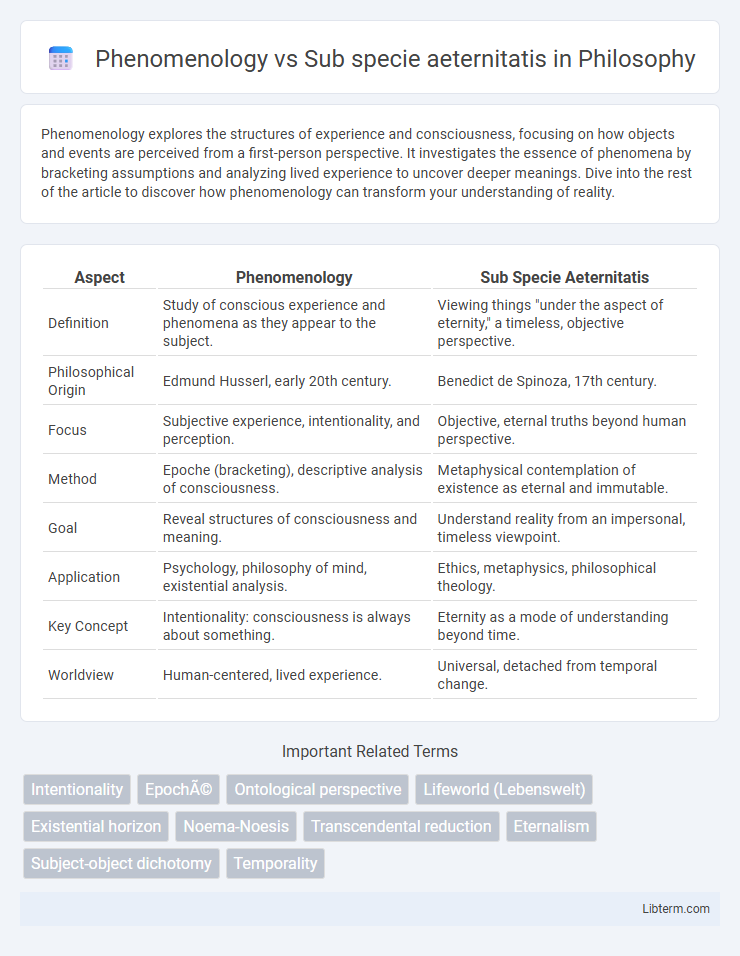Phenomenology explores the structures of experience and consciousness, focusing on how objects and events are perceived from a first-person perspective. It investigates the essence of phenomena by bracketing assumptions and analyzing lived experience to uncover deeper meanings. Dive into the rest of the article to discover how phenomenology can transform your understanding of reality.
Table of Comparison
| Aspect | Phenomenology | Sub Specie Aeternitatis |
|---|---|---|
| Definition | Study of conscious experience and phenomena as they appear to the subject. | Viewing things "under the aspect of eternity," a timeless, objective perspective. |
| Philosophical Origin | Edmund Husserl, early 20th century. | Benedict de Spinoza, 17th century. |
| Focus | Subjective experience, intentionality, and perception. | Objective, eternal truths beyond human perspective. |
| Method | Epoche (bracketing), descriptive analysis of consciousness. | Metaphysical contemplation of existence as eternal and immutable. |
| Goal | Reveal structures of consciousness and meaning. | Understand reality from an impersonal, timeless viewpoint. |
| Application | Psychology, philosophy of mind, existential analysis. | Ethics, metaphysics, philosophical theology. |
| Key Concept | Intentionality: consciousness is always about something. | Eternity as a mode of understanding beyond time. |
| Worldview | Human-centered, lived experience. | Universal, detached from temporal change. |
Introduction to Phenomenology and Sub Specie Aeternitatis
Phenomenology, founded by Edmund Husserl, explores conscious experience by examining phenomena as they appear to awareness, emphasizing subjective perception and intentionality. Sub specie aeternitatis, a Latin phrase meaning "from the perspective of eternity," refers to an objective, timeless viewpoint often associated with Spinoza, where events and experiences are understood in the context of the universe's eternal nature. The contrast between phenomenology's focus on lived experience and subjective consciousness and sub specie aeternitatis's focus on an eternal, impersonal perspective highlights two distinct approaches to understanding reality and existence.
Defining Phenomenology: Core Concepts
Phenomenology centers on the direct exploration of conscious experience, emphasizing intentionality, where every mental act is directed toward an object. It seeks to uncover the structures of experience by bracketing assumptions and focusing on phenomena as they present themselves to consciousness. Contrastingly, sub specie aeternitatis refers to viewing reality from the perspective of eternity, adopting an objective, timeless viewpoint detached from subjective experience.
Understanding Sub Specie Aeternitatis: The Eternal Perspective
Sub specie aeternitatis refers to viewing reality from an eternal, timeless perspective, emphasizing the universe's infinite and immutable nature beyond individual experiences. Phenomenology, contrastingly, concentrates on direct human experience and consciousness, exploring how phenomena appear to individuals in time. Understanding sub specie aeternitatis provides a cosmic, objective viewpoint that transcends subjective perception, framing existence within the vast continuum of eternity.
Historical Origins and Philosophical Contexts
Phenomenology, founded by Edmund Husserl in the early 20th century, emphasizes the direct exploration of conscious experience and the structures of phenomena as they appear to subjective awareness. Sub specie aeternitatis, a Latin phrase meaning "under the aspect of eternity," originates from Baruch Spinoza's 17th-century metaphysics, framing reality from an eternal, objective viewpoint beyond human perspective. These philosophical contexts highlight phenomenology's focus on lived, temporal experience versus Spinoza's timeless, holistic vision of existence as understood through rational comprehension.
Key Thinkers: Husserl and Spinoza
Edmund Husserl's phenomenology explores conscious experience by examining phenomena as they appear to the subject, emphasizing intentionality and the structures of lived experience. Baruch Spinoza's sub specie aeternitatis presents a view of reality from the perspective of eternity, understanding existence as a single, infinite substance governed by necessity. While Husserl focuses on the subjective, temporal unfolding of consciousness, Spinoza advocates for a timeless, objective perspective that reveals the interconnectedness of all things.
Subjective Experience vs. Objective Eternity
Phenomenology centers on subjective experience, emphasizing how individuals perceive and interpret reality through consciousness and intentionality. In contrast, Sub specie aeternitatis views existence from an objective, eternal perspective, detaching from temporal and personal biases to grasp universal truths. This philosophical dichotomy highlights the tension between lived, personal phenomena and the impersonal, timeless nature of objective reality.
Methods of Inquiry: Description vs. Contemplation
Phenomenology employs rigorous descriptive methods to capture the lived experience and subjective consciousness by analyzing phenomena as they appear to individuals. In contrast, Sub specie aeternitatis adopts a contemplative inquiry, viewing existence from an eternal or universal perspective beyond temporality and individual experience. The phenomenological method prioritizes detailed description and intentionality, while Sub specie aeternitatis emphasizes abstraction and timeless reflection.
Implications for Meaning and Existence
Phenomenology, emphasizing lived experience and subjective consciousness, frames meaning and existence through individual perception and intentionality, grounding reality in personal engagement. In contrast, sub specie aeternitatis offers a timeless, objective perspective that views existence detached from human temporality, implying meaning as an external, immutable order rather than experiential. The implications center on whether meaning is constructed through personal, temporal experience or understood as an eternal, fixed truth beyond human subjectivity.
Intersections and Divergences
Phenomenology centers on first-person experiences and the structures of consciousness, emphasizing how phenomena appear to individuals in time. Sub specie aeternitatis, a concept rooted in Spinoza's philosophy, adopts a timeless, objective perspective that views reality from the standpoint of eternity, beyond subjective experience. Their intersection lies in both addressing perception and reality, but they diverge fundamentally as phenomenology insists on temporal, lived experience while sub specie aeternitatis abstracts to an eternal, impersonal viewpoint.
Conclusion: Insights from Both Perspectives
Phenomenology emphasizes the subjective experience and consciousness as fundamental to understanding reality, while sub specie aeternitatis offers a detached, timeless perspective that transcends individual experiences. Insights from both perspectives reveal that integrating subjective consciousness with an objective, eternal viewpoint enriches the comprehension of existence and meaning. This synthesis encourages a more holistic grasp of reality, balancing personal lived experience with universal, timeless truths.
Phenomenology Infographic

 libterm.com
libterm.com